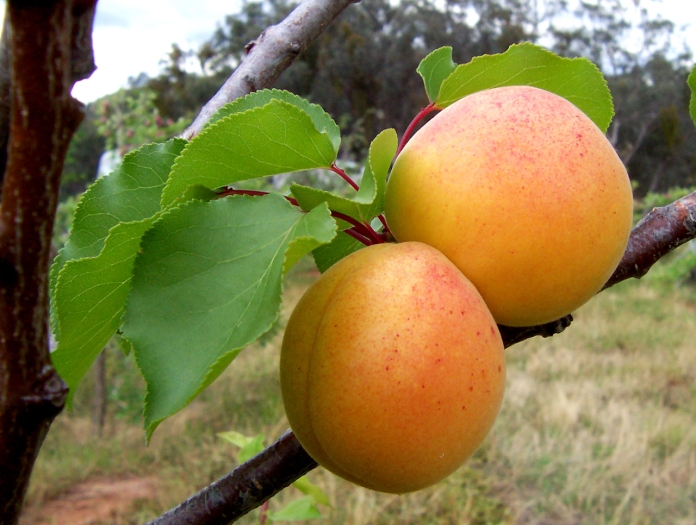Apricot
(Prunus armeniaca)
Apricot (Prunus armeniaca)
/
/

Fir0002
CC BY-SA 3.0
Image By:
Fir0002
Recorded By:
Copyright:
CC BY-SA 3.0
Copyright Notice:
Photo by: Fir0002 | License Type: CC BY-SA 3.0 | License URL: http://creativecommons.org/licenses/by-sa/3.0/ | Uploader: Fir0002 | Publisher: Wikimedia Commons | Title: Apricots.jpg | Notes: {{Information |Description={{en|1=Feral Rose ringed Parakeet eating Bitter Almond blossom in a Teddington garden}} |Source=Own work by uploader |Author=[[User:Jonathan Cardy|Jonathan Cardy]] |Date=2009-03-21 |Permission=I took this photo of a tree I plant |
























































Estimated Native Range
Summary
Prunus armeniaca, commonly known as Apricot, is a deciduous tree native to the temperate regions of Central Asia and East Asia, often found in open woodlands and along riverbanks. Its exact native range is uncertain due to extensive cultivation since prehistoric times, but genetic studies suggest Central Asia as the center of origin. Apricots are small trees, reaching 8–12 m (26–39 ft) in height with a trunk up to 40 cm (16 in) in diameter and a dense, spreading canopy. The flowers, appearing in early spring before the leaves, are 2–4.5 cm (0.8–1.8 in) in diameter with five white to pinkish petals, and are produced singly or in pairs, offering a modest ornamental display. The fruit is a drupe, resembling a small peach, 1.5–2.5 cm (0.6–1.0 in) in diameter, with a color ranging from yellow to orange, often with a red blush. The surface of the fruit may be smooth or velvety with short hairs. The flesh is juicy, and the flavor varies from sweet to tart. The seed is encased in a hard shell with a distinctive grainy texture.
Apricot trees are valued for their edible fruit and are widely cultivated in home gardens and commercial orchards. They are also used as ornamental trees for their spring blossoms. Apricots require full sun and adapt to various soil types, though they prefer well-drained soils. Regular watering is necessary, especially during fruit development. While apricots are generally easy to maintain, they can be susceptible to diseases such as bacterial canker and brown rot. Gardeners should also be aware of potential pests like aphids and caterpillars. Apricots can be propagated by grafting, which also allows for the selection of disease-resistant rootstocks.CC BY-SA 4.0
Apricot trees are valued for their edible fruit and are widely cultivated in home gardens and commercial orchards. They are also used as ornamental trees for their spring blossoms. Apricots require full sun and adapt to various soil types, though they prefer well-drained soils. Regular watering is necessary, especially during fruit development. While apricots are generally easy to maintain, they can be susceptible to diseases such as bacterial canker and brown rot. Gardeners should also be aware of potential pests like aphids and caterpillars. Apricots can be propagated by grafting, which also allows for the selection of disease-resistant rootstocks.CC BY-SA 4.0
Plant Description
- Plant Type: Tree
- Height: 8-10 feet
- Width: 8-10 feet
- Growth Rate: Moderate
- Flower Color: White
- Flowering Season: Spring
- Leaf Retention: Deciduous
Growth Requirements
- Sun: Full Sun
- Water: Medium
- Drainage: Medium
Common Uses
Bee Garden, Bird Garden, Butterfly Garden, Edible*Disclaimer: Easyscape's listed plant edibility is for informational use. Always verify the safety and proper identification of any plant before consumption., Fragrant, Potted Plant, Rabbit Resistant, Showy Flowers
Natural Habitat
Temperate open woodlands and riverbanks
Other Names
Common Names: Albaricoque, Damasco, Aprikose, Abrikoos, 杏
Scientific Names: , Prunus armeniaca, Armeniaca vulgaris, Prunus amarella, Amygdalus armeniaca, Amydalus armeniaca, Armeniaca anomala, Armeniaca armeniaca, Armeniaca batavica, Armeniaca berricoccia
GBIF Accepted Name: Prunus armeniaca L.